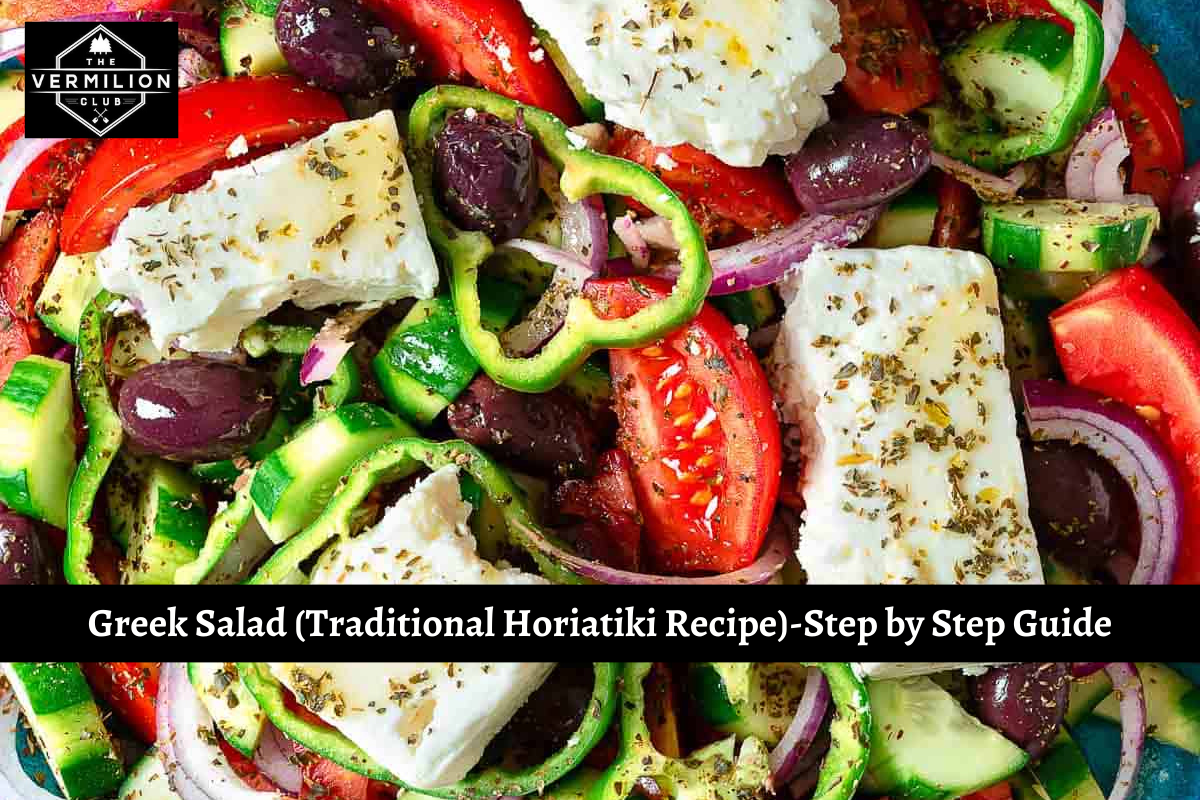Greek Salad (Traditional Horiatiki Recipe)-Step by Step Guide:-The one thing that can be found on any Greek table. For good reason, this is the most famous Greek salad that people eat all over the globe. Once you toss it and the flavours blend, it’s incredibly easy to make and tastes great.
Greek Salad (Traditional Horiatiki Recipe)-Step by Step Guide
All of the ingredients are natural, unprocessed, and uncomplicated. A perfectly ripe tomato, cut into chunks, is the best thing ever. The dressing would not be the same without the juices. Green bell peppers are the norm in this region. From there, I wouldn’t deviate. An onion, particularly a red onion, would be my choice.
Thinly slice all ingredients (with the exception of the tomatoes). Like a micro chop salad, I think this is the best way to make them. For the most flavorful olive oil, use extra virgin. The tanginess that is essential for this easy salad dressing is also provided by the red wine vinegar.
As shown at the top of the page, the traditional way to serve this salad to family or friends is to place the feta block on top of the sliced ingredients in a large bowl. To complement the salad, it is essential to provide fresh bread to soak up the juices that settle to the bottom of the bowl.
Ingredients
- 5 large tomatoes or 20 cherry tomatoes
- ½ red onion
- ½ cucumber
- 1 green pepper
- 20 black Kalamata olives , pitted and sliced or whole
- 7 oz (200g) block feta cheese
- 1 tbsp red wine vinegar
- 4 tbsp extra virgin olive oil , or to taste
- 1 teaspoon dried oregano , plus extra to garnish
- sea salt , to taste
Also Read:-Banana Walnut Breads Recipe-Learn Like a Pro
Instructions
- Put your vegetables through a thorough washing to get them ready.
- Create chunky, irregular wedges out of your tomatoes by slicing them.
- If you are using any tomatoes that are smaller, cut them in half. A salad bowl should be used to hold the tomatoes.
- Although I prefer to use a mandolin for this task, you can certainly use a knife instead. The onion should be sliced into thin half moon slices.
- Green peppers should be topped, and the seeds and white membranes should be thrown away. Cut the meat into rounds.
- The seeds should be removed from the cucumber (unless it is extremely crisp!), and then the cucumber should be sliced into half moons or rounds.
- In a salad bowl, combine all of the vegetables and olives, and then liberally sprinkle with a generous amount of sea salt.
- After adding the red wine vinegar and generously drizzling with olive oil, gently toss everything together until it is evenly distributed.
- Allow the salad to sit at room temperature for fifteen to twenty minutes so that the tomatoes can release some of the juices that they originally contained.
- A block of feta cheese or two large wedges of feta cheese should be placed on top of the salad, and then additional olive oil and a little bit of dried oregano should be drizzled over it.
- Pita or slices of Horiatiko bread should be served alongside the salad so that the salad juices can be dipped into and mopped up with each and every delicious drop.
Notes
- For a couple of days, any salad that is left over can be stored in the refrigerator. Due to the fact that the vegetables will lose some of their crispness, I prefer to serve them with some orzo pasta or to supplement the leftovers with some tomatoes that have been freshly cut.
- Because the quality of a traditional Greek salad is directly proportional to the quality of its components, it is typically served during the summer months and into the autumn, when the components are in season and in abundance. If the tomatoes are watery and tasteless, the salad will be a letdown for the person who serves it.
- Before you use the feta cheese, give it a taste. It is possible that you will need to adjust any additional salt that is in the salad if it is high in salt.
Nutritional Info
- Calories: 1298kcal
- Carbohydrates: 45g
- Protein: 37g
- Fat: 113g
- Saturated Fat: 36g
- Polyunsaturated Fat: 9g
- Monounsaturated Fat: 59g
- Cholesterol: 177mg
- Sodium: 3551mg
- Potassium: 2058mg
- Fiber: 14g
- Sugar: 22g
- Vitamin A: 6857IU
- Vitamin C: 185mg
- Calcium: 1148mg
- Iron: 5mg
If you like this article about Greek Salad (Traditional Horiatiki Recipe)-Step by Step Guide. Please share this article with your friends and family members.



